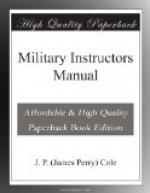(b) The rifle grenadiers advance at once just as close as possible, but at all costs to within effective grenade range. They then take cover in shell holes, trenches, etc., and open up a rapid fire. They are the long distance howitzers of the platoon and are very valuable. By a well placed grenade the whole resistance may be overcome. This section usually works around a flank.
(c) The riflemen work up by squad as far as practicable and to a flank, when an opportunity presents itself, the squad opens fire in such a manner as to protect advance of other squads or teams.
(d) The bombers endeavor to get well around behind the enemy and taking advantage of cover get to within bomb range. They may be compared to the close range howitzers or trench mortars.
When all four sections are in action at proper ranges, the opposition can probably last but a short time, and as soon as the machine guns cease fire the platoon, especially the riflemen, go after the remainder of the garrison with the bayonet.
[Illustration: Plate #27]
It may happen that the barrage put up will so demoralize the enemy that the riflemen can advance before his machine guns are even put out of action. This operation allows the rifle men to get in with the bayonet, if the resistance is not sooner overcome.
When the different sections are getting to their places, they usually find enough shell holes or old trenches to obtain cover. They should not move as entire sections, but as small groups of three or four at a time.
8. After the encircling movement has once begun, the platoon commander loses all control, and the action is then conducted by the section, squad or team leaders. They must be trained to act on their own initiative, as further orders are rarely practicable.
The resistance will finally be overcome, either because the enemy will retreat or surrender under the menace of encirclement, or by the losses caused by our fire or by the attack at close range of our bombers or else by the final assault with the bayonet led by our riflemen.
It must be remembered that under an artillery barrage it is never possible to issue verbal orders, so the sections must be trained to understand and obey the arm signals of its officer, or more often to work without orders.
9. A sequence of command must be arranged in each section, squad and team down to the last man.
REMARKS REGARDING THE FORMING OF WAVE FROM CLOSE ORDER.
The sketch of deployment attached is an illustration of one of the formations that may be adopted. It is given as an example. Any other wave formation may be practically as easily formed up. The platoon commander simply calls out the squads he wants in the first line.
It must not be imagined that this transition from close order to extended is done in the field when actually under fire or as a result of surprise.




